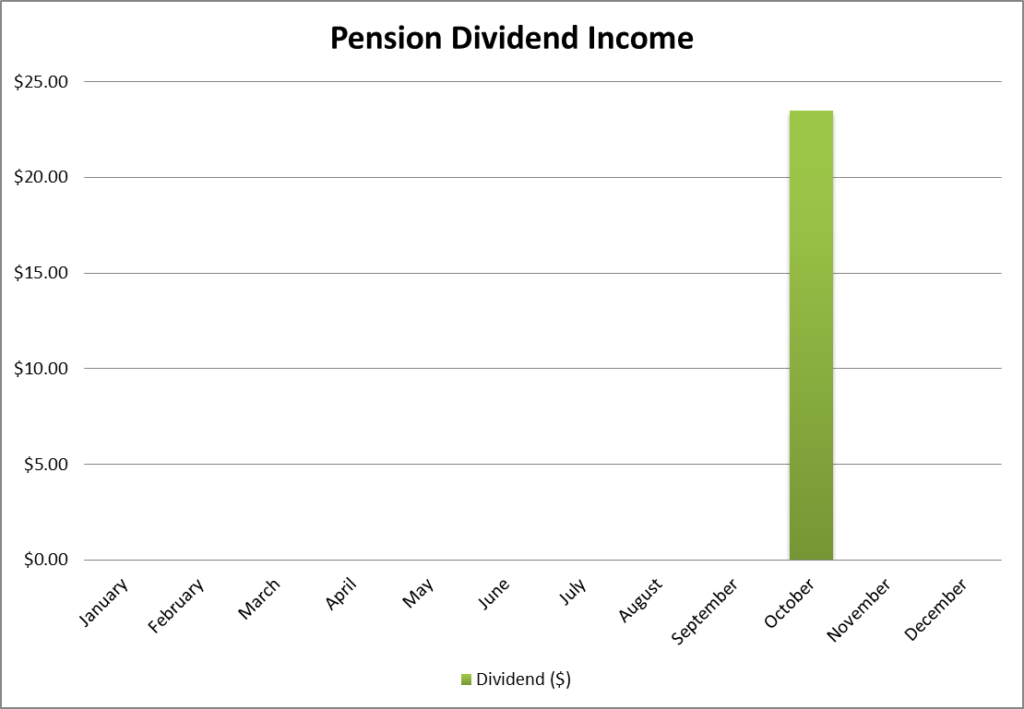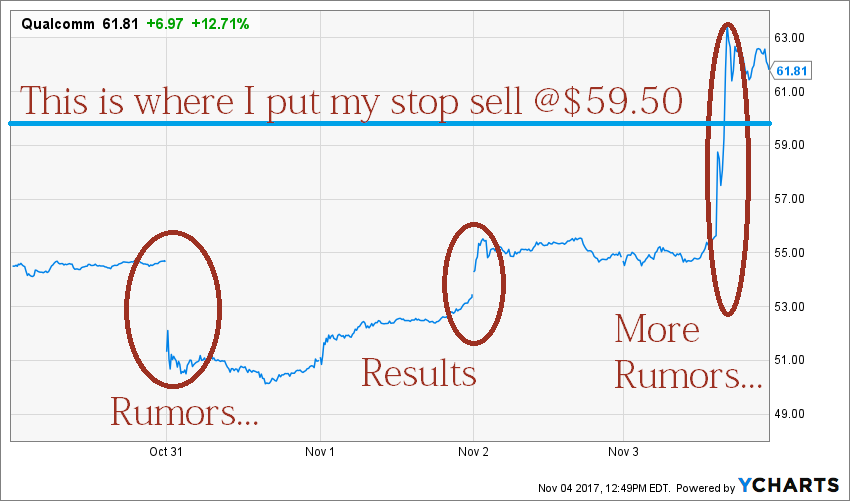Am I really doing this? After explaining why I dislike dividend income reports, I’m jumping on the train… But I decided to do it for one specific reason: I want to track my performance from scratch. In September, I started investing 100K in the stock market. This is the result of the commuted value of my pension plan. To be honest, I still don’t care about my monthly or quarterly dividend income. For me, tracking the money I receive in my brokerage account still has no value. However, I thought this live experiment would be a good idea for any new investors that can read about how I build and manage a retirement portfolio over the long haul. I will discuss a little bit more about my portfolio than how much I made from it. Still, keeping track of the monthly dividend income will help show investors the power of dividend growth investing… and I will also be able to show you that you can build a solid DG portfolio without aiming at 5%+ yielding stocks. Yeah, on top of my dislike for dividend income reports, I also dislike stocks paying over 5% yield. I don’t know, they all remind me of Kinder Morgan (KMI)… hahaha!
Portfolio holdings
I didn’t waste much time when I received my money during the first week of September. About 6 weeks later, I’ve invested roughly 80% of it. I’ve separated my portfolio into Canadian and US stocks. Each section shows values in their original currency (e.g. Canadian portfolio shows CAD and US portfolio shows US value).
| Company Name | Ticker | Market Value |
| Alimentation Couche-Tard | ATD.B.TO | $5,290.72 |
| Andrew Peller | ADW.A.TO | $5,191.25 |
| Royal Bank | RY.TO | $6,071.40 |
| Lassonde Industries | LAS.A.TO | $5,194.56 |
| Cash | $19,936.56 | |
| Total | $41,684.49 |
I’m not done yet building this part of my portfolio. I have room for an additional four selections. I will look into earnings in the upcoming weeks to make some decisions. I’m not in a hurry, but I like when my money is invested.
I went with unconventional picks like Alimentation Couche-Tard, Andrew Peller and Lassonde Industries. I know, their yields suck, but their growth is phenomenal. Therefore, I don’t mind. In the end, their dividend will be more than generous in 29 years from now when I will really need money. Plus, I’m sure they will all show impressive stock returns! In the end, what matters the most is how much your portfolio worth, not how much it pays you. I rather have a 1.5M$ portfolio paying a 2% yield than a $1M$ portfolio paying a 5% yield. But that’s just me!
| Company Name | Ticker | Market Value |
| Apple | AAPL | $5,365.01 |
| Disney | DIS | $4,459.49 |
| Gentex | GNTX | $4,573.10 |
| Hasbro | HAS | $4,163.46 |
| Honeywell | HON | $4,649.60 |
| Lazard | LAZ | $4,758.30 |
| Microsoft | MSFT | $5,059.50 |
| Qualcomm | QCOM | $4,382.00 |
| Starbucks | SBUX | $4,831.40 |
| Texas Instruments | TXN | $4,866.05 |
| United Parcel Services | UPS | $4,289.04 |
| Visa | V | $5,561.50 |
| Cash | $131.20 | |
| Total | $57,089.65 |
I’ve finished building my US portfolio in the first week of November when I analyzed Visa (V) and decided it would be a perfect fit for a long term portfolio. The whole world is shifting from cash transactions to digital and credit cards means. What better move than investing in the world leader in both fields? Even better, Visa is already in the cryptocurrency bandwagon with their Bitcoin credit card.
I have an overexposure to the techno sector, and I’m well under represented in healthcare and energy sector, for example. Unfortunately, I didn’t find any interesting stock to purchase in those fields recently. Each stock is handpicked following my 7 dividend growth investing principles. The very same investing rules that helped me build highly-performing portfolios in Dividend Stocks Rock (you can get an idea of my performance here).
Dividend income: $23.50
Hey, I started my portfolio in September and I’m already reaping some benefits! All right, $23.50 is not even enough to pay for a pizza for my family, but still, it pays for a good bottle of wine!

I expect this graph to be a lot more interesting in the upcoming years, but I wanted to track it since day #1. In October, I received dividend from my investment in Gentex (GNTX). As I am not done building my overall portfolio, I rather gather cash than dripping. Soon enough, I will start dripping my account (probably in 2018 once the portfolio is fully invested).
Total Return
I started investing money in my Canadian account on September 7th where I bought shares of Royal Bank (RY.TO). I started the U.S. portfolio 2 days before (September 5th) with the purchase of SBUX, QCOM and LAZ. I will use those two dates for benchmarking (keep in mind, I will be disadvantage as my portfolio was mostly cash at that time).
I like to compare my performance to a dividend ETF. It gives me an indication of how I do on the stock market and if I should continue to manage my portfolio by myself or let professional do it for me. After all, there is no point in spending time managing my money if I could take 2 minutes, buy the VIG and XDV and make more money. This would be a defective way of allocating my time. Here are the results as at November 3rd 2017 at market closing:
Canadian portfolio: +6.87%
XDV: +8.46%
Added Value: -1.59%
U.S. Portfolio: +4.60%
VIG: +5.73%
Added Value: -1.13%
I’m trailing behind both benchmarks after 2 months, but this makes sense. Since both markets went up and I was sitting on a pile of cash, it was virtually impossible to beat my benchmarks. The problem with benchmarks is that you have to wait a good 3-4 years before knowing if you are doing the right thing or not. Therefore, you are always better off sticking to your strategy as long as you don’t lag too much. Don’t try to beat your benchmark or the market by going off your strategy. You will end-up digging a larger hole and you will fall into it.
Final thoughts – a Good use of a Stop Sell
I will end this post with a live example of how a stop sell should be used. First, a stop sell is a trade feature enabling you to start selling a stock at a specific price. It doesn’t mean you really want to sell it, but it protects your profit (or minimise your loss) upon market swings.
In my current portfolio, I have one pick that was a “calculated gamble”. Once in a while, I like to pick a stock that is greatly undervalued due to a riskier situation. This pick is Qualcomm (QCOMM). The company is having problems with anti-trust rules and it is fighting with both the Chinese government and Apple (AAPL), the wealthiest company on Earth. That bad news brought QCOM stock to drop sharply and I picked up some shares in the low $50’s. At that time, the stock was down by over 20% since the beginning of the year.
Then, three major events happened during the very same week. First a rumor that Apple could drop Qualcomm for its next iPhone generation. Then, management published robust earnings (considering the situation). Finally, more rumors about Broadcom (AVGO.O) that could purchase QCOM at $70+ a share. Here’s what happened on the market:

Source: Ycharts
As you can see, there is lots of volatility around the stock. I purchased QCOM at $50 not too long ago. On one side, I think it can go higher if the rumor reveals to be true. After all, Broadcom is expected to pay over $70 per share. I don’t want to miss that occasion. On the other side, I know for sure that if the rumor falls short, QCOM will drop like a rock. I have a unique opportunity to cash a 20% return over 2 months, I’m not going to let it go. For this reason, I intend to hold QCOM, but I put a stop sell at $59.50 to secure my profit.
It’s important to note that I’m not using stop sell on my holdings in general. The reason is simple: I intend to hold them for years, read decades… or maybe for life! However, I also allow a part of my capital to be invested in a riskier pick in order to generate additional growth. The goal is to hold this pick for a maximum of 2 years based on my investment thesis. QCOM has already generated enough return to fit in this strategy… but I’m not going to let go of another $10 per share if Broadcom is willing to purchase it at $70!
***I wrote this article last Friday. On Monday Morning, The news was confirmed and decided to sell at $64.90. That made a healthy 29% profit within a few weeks. Not bad!
